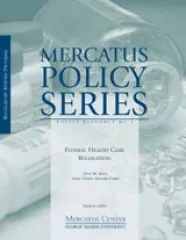- | Healthcare Healthcare
- | Expert Commentary Expert Commentary
- |
SCOTUS Tackles Health Care Law: Five Possible Outcomes
The health care law's Supreme Court case could result in four scenarios, said Chuck Blahous, a senior research fellow at the Mercatus Center at George Mason University. Blahous is the author of a forthcoming Mercatus research paper on the financial impact of the health care law.
First Scenario: The health care law both passes constitutional muster and its cost-saving provisions are all perfectly enforced. Even in this fiscally optimistic scenario, the health care law will add more than $1.15 trillion to federal spending in the next 10 years, and at least $340 billion to federal deficits.
Second Scenario: The health care law passes constitutional muster, but some of its cost-savings provisions—one being IPAB—are later overridden, repealed or scaled back. In that instance, we're probably looking at more than $500 billion added to federal deficits in the next 10 years, and more than $1.24 trillion in new spending.
Third Scenario: Part of the law, for example the purchase mandate, is struck down on constitutional grounds. In that case, the fiscal results become wildly unpredictable. CBO has projected that eliminating the mandate would improve federal finances by roughly $282 billion over ten years. This would ameliorate the law’s fiscal damage, but not by enough to render it a net fiscal gain. In this scenario, other remaining aspects of the law may render it unworkable for health care consumers and insurers alike; CBO estimates that these other requirements of the law could push health premiums up by 15-20%.
Fourth Scenario: If the health care law is struck down entirely, and none of its provisions are enforced, our fiscal situation would improve. Spending would be $1.15 trillion lower over the next 10 years, and deficits would be $340 billion lower than if the law were allowed to go into full effect.
Fifth Scenario: Though no one expects it to happen, a hypothetical fifth scenario is an illustrative best-case outcome from the perspective of federal finances. That would involve striking down the law’s subsidized health coverage expansions while permitting its other cost-savings provisions to stand. This is not a scenario that the Supreme Court is expected to explore.
Photo Credit: Pete Souza/White House
